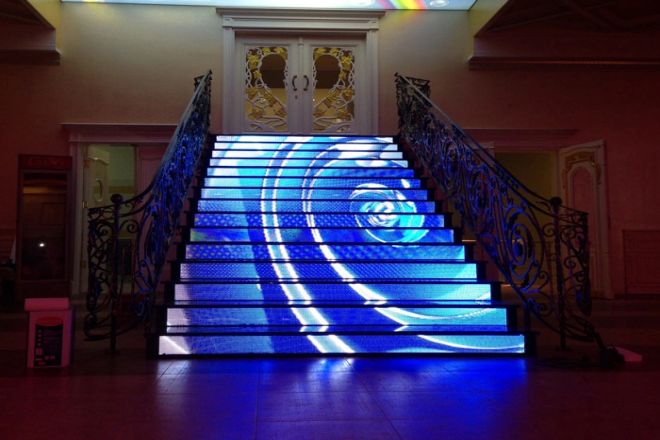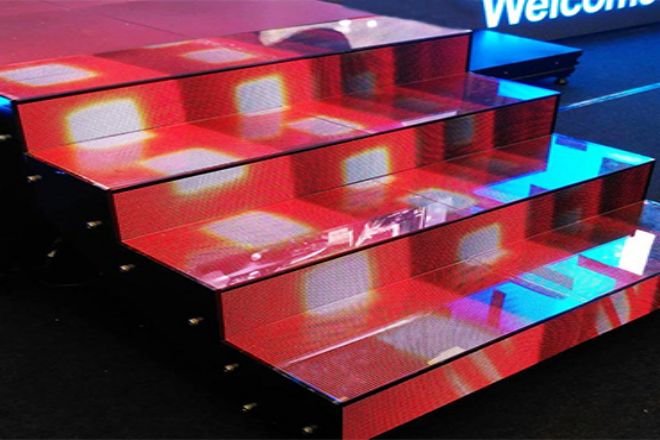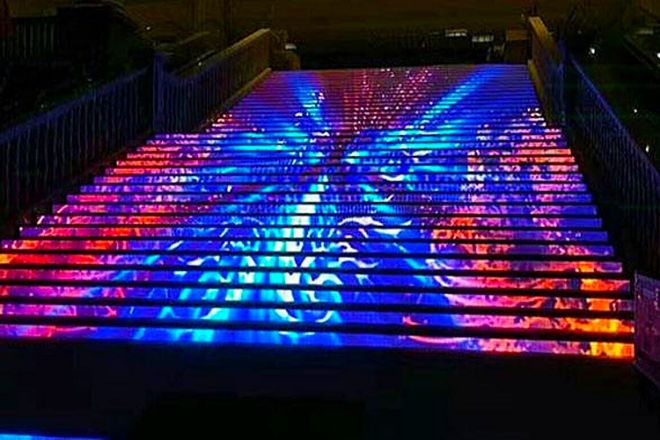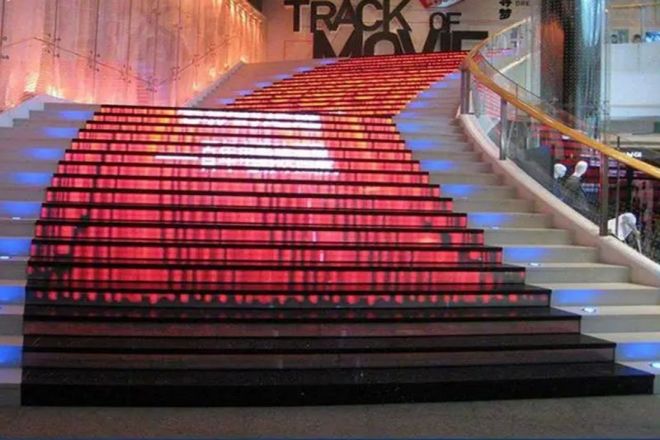مقدمة

باعتبارها عنصرًا مروريًا رأسيًا في المبنى، فإن السلالم لا تحمل الوظيفة الأساسية لربط الطوابق فحسب، بل تصبح أيضًا تقاطعًا لخطوط الرؤية والحركة بسبب شكلها وموقعها الفريد.
إن دمج شاشات العرض LED في تصميم السلالم ليس مجرد محاولة جريئة لاستغلال المساحة، بل هو أيضًا استكشاف عميق لعمق دمج الفن والتكنولوجيا.
تخيل أن كل خطوة تسلق مصحوبة بتغيرات في الضوء والظل، وأن كل توقف يستشعر تدفق المعلومات. ستأخذك هذه المقالة لاستكشاف الإمكانيات اللامتناهية لـ شاشات عرض LED أرضية في هذا المشهد الجديد للسلالم، نكشف كيف يعيد تشكيل مساحة الدرج.
1. هل يمكن تركيب شاشات عرض LED الأرضية على كافة السلالم؟

لا يُمكن تركيب شاشات عرض LED أرضية على جميع السلالم. هناك العديد من العوامل التي يجب مراعاتها عند تركيب شاشات عرض LED أرضية على السلالم، منها على سبيل المثال لا الحصر النقاط التالية:
1) القيود المكانية والبنيوية:
يؤثر عرض وارتفاع وعمق وقوة تحمل الدرج على تركيب شاشة عرض LED. تحتاج شاشة العرض إلى مساحة كافية للتركيب، كما أن وزنها وطريقة تركيبها يضمنان ثبات هيكل الدرج وسلامته.
2). مزود الطاقة:
تتطلب شاشة عرض LED الأرضية مصدر طاقة مستقرًا. عند تركيب شاشة عرض في قاعة الدرج، من الضروري تقييم توزيع خطوط الطاقة وكفاية سعة الطاقة لضمان تشغيلها بشكل طبيعي.
3) عوامل السلامة:
السلالم مناطق يكثر فيها حركة الأفراد، لذا تُعد عوامل السلامة بالغة الأهمية. يجب أن يكون تركيب شاشة العرض ثابتًا وموثوقًا به لمنع الإصابات الشخصية الناتجة عن السقوط أو الانقلاب.
وفي الوقت نفسه، يجب أيضًا تصميم سطوع وتوزيع الضوء لشاشة العرض بشكل معقول لتجنب التداخل البصري أو المخاطر الأمنية للمشاة.
4) متطلبات الاستخدام والتكاليف:
عند تركيب شاشة عرض LED أرضية على الدرج، تُراعى أيضًا متطلبات الاستخدام المحددة وفعالية التكلفة. إذا كان استخدام منطقة الدرج منخفضًا، أو لم يكن تأثير العرض مطلوبًا، فقد لا يكون تركيب الشاشة فعالًا من حيث التكلفة.
5) اللوائح والأنظمة:
في بعض المناطق أو الأماكن المحددة، قد تكون هناك لوائح خاصة بتركيب شاشات عرض LED. قبل التركيب، من الضروري فهم هذه اللوائح والالتزام بها لضمان الامتثال.
باختصار، على الرغم من أن استخدام شاشات عرض LED الأرضية على السلالم يُعدّ إبداعيًا وجذابًا، إلا أن تركيبها ليس مُناسبًا لجميع السلالم. في التطبيقات العملية، يتطلب الأمر تقييمًا شاملًا واتخاذ قرار بناءً على ظروف مُحددة.
إذا كانت السلالم تلبي شروط التثبيت ولديها احتياجات استخدام واضحة وفوائد اقتصادية، فسيكون تركيب شاشة LED الأرضية خيارًا جيدًا.
2. لماذا تعتبر شاشة LED أرضية، ولا يمكن استخدام شاشات LED أخرى؟
يعود تفضيل استخدام شاشات LED الأرضية على السلالم بشكل رئيسي إلى مزاياها وخصائصها الفريدة، والتي يصعب استبدالها بأنواع أخرى من شاشات LED. إليك بعض الأسباب الرئيسية:
1) تفرد موقع التثبيت والأداء:
شاشة LED الأرضية هي الوحيدة من بين العديد من شاشات LED التي يُمكن تركيبها على الأرض، ويمكن للناس المشي عليها. ولهذا السبب تحديدًا، يجب أن تكون شاشة LED المُركّبة على السلالم هي الخيار الأمثل.
2) القدرة على التكيف المكاني:
باعتبارها مساحة مرورية رأسية، فإن شكل وبنية السلالم لها خصوصيات معينة.
يمكن تخصيص شاشة LED الأرضية وفقًا للشكل والحجم المحددين للسلالم لضمان ملاءمة مثالية لهيكل الدرج دون شغل مساحة إضافية كبيرة جدًا.
تجعل هذه الدرجة العالية من القدرة على التكيف المكاني شاشة LED الأرضية خيارًا مثاليًا لتزيين السلالم وعرض المعلومات.
3) التفاعلية:
تدعم بعض شاشات LED الأرضية وظائف اللمس أو الاستشعار ويمكنها التفاعل مع المشاة.
من خلال تثبيت شاشة العرض هذه على الدرج، يمكنك تصميم روابط تفاعلية مختلفة ومثيرة للاهتمام، مثل تشغيل الموسيقى ومقاطع الفيديو على شاشة اللمس، أو عرض محتوى مختلف عن طريق استشعار تحركات المشاة.
لا يؤدي هذا التفاعل إلى زيادة متعة السلالم فحسب، بل يعزز أيضًا الشعور بالمشاركة والخبرة لدى المشاة.
4) تحمل الأحمال والاستقرار:
باعتبارها منطقة ذات تدفق متكرر للموظفين، فإن السلالم لها متطلبات عالية لتحمل الأحمال واستقرار شاشة العرض. عادةً ما تكون شاشات العرض LED الأرضية مصنوعة من مواد عالية القوة ولها خصائص ممتازة في تحمل الأحمال ومقاومة الصدمات.
وفي الوقت نفسه، تم تصميم هيكل التثبيت الخاص به بعناية لضمان الاستقرار والسلامة في ظل الاستخدام طويل الأمد والخطوات المتكررة.
3. ما هي فوائد تركيب شاشات العرض LED الأرضية على السلالم؟

يؤدي تركيب شاشات العرض LED الأرضية على السلالم إلى تحقيق العديد من الفوائد، بما في ذلك الجوانب التالية بشكل أساسي:
1) تعزيز التأثيرات البصرية والجمال المكاني:
يمكن لشاشة عرض LED الأرضية أن تعزز بشكل كبير التأثيرات البصرية لمنطقة الدرج بفضل ارتفاعها سطوع، ألوان زاهية وعالية الوضوح. يُحوّل الدرج إلى مساحة عرض ديناميكية وحيوية، مُضفيًا لمسةً من الحداثة والتكنولوجيا على البيئة العامة.
من خلال تشغيل صور أو مقاطع فيديو أو رسوم متحركة جميلة، يمكن لشاشات LED خلق جو فريد من نوعه، مما يجعل السلالم محورًا جذابًا للنظر ويعزز جمال المساحة بشكل عام.
2) تعزيز كفاءة نقل المعلومات:
باعتبارها منطقة مزدحمة، فإن تركيب شاشات LED يمكن أن ينقل معلومات مختلفة بكفاءة، مثل أدلة الأرضية، ونصائح السلامة، والعروض الترويجية للأحداث، وما إلى ذلك.
يتم عرض هذه المعلومات للمشاة بطريقة بديهية وحيوية، مما يحسن كفاءة ودقة نقل المعلومات.
بالنسبة للأماكن التجارية، يمكن أيضًا استخدام شاشات LED لعرض محتوى الإعلان وجذب انتباه العملاء وتعزيز صورة العلامة التجارية وأداء المبيعات.
3) تحسين تجربة المستخدم والتفاعل:
تدعم بعض شاشات LED الأرضية وظائف اللمس أو الاستشعار، والتي يمكنها التفاعل مع المشاة.
ومن خلال تصميم روابط تفاعلية مثيرة للاهتمام، مثل لمس الشاشة لتشغيل الموسيقى والفيديو أو المشاركة في الألعاب، يمكن تعزيز شعور المستخدم بالمشاركة والخبرة.
لا يؤدي هذا التفاعل إلى زيادة متعة السلالم فحسب، بل يسمح أيضًا للمستخدمين بالترفيه والاسترخاء أثناء الانتظار أو المشي، مما يحسن رضا المستخدم بشكل عام.
4) تحسين استغلال المساحة:
عادة ما تكون مساحة الدرج محدودة، ولكن تركيب شاشات LED الأرضية يمكن أن يجعل الاستفادة الكاملة من هذه المساحة للعرض والترويج.
بالمقارنة مع الملصقات واللافتات التقليدية وغيرها من طرق الدعاية، تتمتع شاشات العرض LED بقدرة أعلى على حمل المعلومات وتأثيرات بصرية أفضل ويمكنها تحقيق نشر معلومات أكثر كفاءة في مساحة محدودة.
5) تعزيز بناء العلامة التجارية والتواصل الثقافي:
بالنسبة للمؤسسات، مراكز التسوقفي المؤسسات الثقافية، يمكن تركيب شاشات عرض LED أرضية على السلالم كمنصة دعائية مهمة. فعرض صورة العلامة التجارية، أو المفاهيم الثقافية، أو معلومات عن الفعاليات يُعزز معرفة الجمهور بالمؤسسة وذاكرته، ويُعزز بناء العلامة التجارية والتواصل الثقافي.
6) تعزيز السلامة:
في بعض الحالات الخاصة، مثل حالات الإخلاء في حالات الطوارئ، يمكن لشاشات عرض LED أيضًا عرض تعليمات الطوارئ لتوجيه الحشود للإخلاء بشكل منظم. هذه الميزة لا تُحسّن السلامة فحسب، بل تُبرز أيضًا أهمية وفائدة شاشات عرض LED.
4. كم تكلفة تركيب شاشة عرض LED الأرضية على الدرج؟
تتأثر تكلفة تركيب شاشة عرض LED أرضية على السلالم بعوامل عديدة، لذا من المستحيل تحديد رقم محدد. مع ذلك، يمكن تقدير نطاق التكلفة بشكل تقريبي بناءً على بعض العوامل المؤثرة الشائعة. فيما يلي بعض العوامل الرئيسية المؤثرة على التكلفة:
1) حجم شاشة العرض و دقة:
كلما كانت شاشة العرض أكبر، كلما كانت هناك حاجة إلى عدد أكبر من مصابيح LED، وبالتالي ارتفعت التكلفة.
كلما زادت الدقة، كلما كان تأثير العرض أكثر وضوحًا، ولكن هذا سيؤدي أيضًا إلى زيادة التكلفة.
لذلك، فإن عرض وارتفاع الدرج وتأثير العرض المطلوب سيؤثر بشكل مباشر على اختيار حجم ودقة شاشة العرض، ومن ثم يؤثر على التكلفة الإجمالية.
2) تكنولوجيا وجودة شاشة العرض:
تقنيات شاشة العرض LED المختلفة (مثل إس إم دي, كوب(وإلخ) ودرجات الجودة (مثل جودة حبة المصباح، ونظام التحكم، وما إلى ذلك) ستؤثر على السعر.
عادةً ما تتمتع شاشات العرض عالية الجودة وعالية التقنية بتأثيرات عرض أفضل وعمر خدمة أطول ومعدلات فشل أقل، ولكن السعر سيرتفع أيضًا وفقًا لذلك.
3) صعوبة التثبيت والتكلفة:
قد يؤثر شكل الدرج وبنيته والبيئة المحيطة به على صعوبة التركيب وتكلفته.
إذا كان شكل الدرج معقدًا، أو المساحة محدودة أو كانت هناك حاجة إلى طريقة تركيب خاصة (مثل الرفع، والتثبيت، وما إلى ذلك)، فقد تزيد تكلفة التركيب.
4) التكاليف الأخرى:
بالإضافة إلى تكلفة شاشة العرض نفسها، يجب أيضًا مراعاة تكلفة المعدات الداعمة مثل مصدر الطاقة ونظام التحكم وخط النقل وقوس التثبيت.
وبالإضافة إلى ذلك، إذا كان الأمر يتعلق بالتصميم والبناء والتشغيل وخدمات أخرى، فيجب دفع رسوم الخدمة المقابلة.
5. كيفية الحفاظ على شاشة العرض LED الأرضية على الدرج؟

تُعد صيانة شاشة عرض LED الأرضية على السلالم جزءًا أساسيًا من ضمان استقرارها على المدى الطويل وإطالة عمرها الافتراضي. إليك بعض خطوات الصيانة والاحتياطات الأساسية:
1) التفتيش اليومي
- التحقق من مظهر الشاشة:
افحص سطح الشاشة بانتظام بحثًا عن الخدوش أو الشقوق أو الانبعاجات.
تحقق مما إذا كانت هناك أجسام غريبة متصلة بالشاشة، مثل الغبار، أو قطرات الماء، وما إلى ذلك.
- التحقق من خطوط الاتصال:
تأكد من توصيل جميع كابلات الطاقة وكابلات الإشارة بشكل محكم دون أن تتفكك أو تسقط.
تحقق مما إذا كانت الخطوط تالفة أو قديمة أو تحتوي على أجزاء معدنية مكشوفة.
- التحقق من نظام التبريد:
يُعد نظام تبريد الشاشة أساسيًا لاستقرار عملها. تأكد من عمل المروحة والمشتت الحراري والمكونات الأخرى بشكل صحيح لضمان تبديد الحرارة بشكل جيد.
2) التنظيف المنتظم
- تنظيف سطح الشاشة:
امسح سطح الشاشة برفق باستخدام قطعة قماش ناعمة وجافة أو قطعة قماش خالية من الغبار لإزالة الغبار والأوساخ.
لا تستخدم المنظفات أو الأقمشة المبللة التي تحتوي على مواد كيميائية لمسح الشاشة لتجنب إتلاف الطبقة السطحية أو التسبب في حدوث ماس كهربائي في الدائرة الداخلية.
- تنظيف المكونات الداخلية:
إذا كنت بحاجة إلى تنظيف المكونات الداخلية للشاشة (مثل لوحات الدوائر، ومحركات الأقراص، وما إلى ذلك)، فتأكد من القيام بذلك تحت إشراف متخصصين وتأكد من إجراء العملية في حالة إيقاف التشغيل.
3) التشغيل والإيقاف الصحيحين
- تسلسل التشغيل:
أولاً، قم بتشغيل جهاز التحكم (مثل الكمبيوتر أو وحدة التحكم وما إلى ذلك)، ثم قم بتشغيل شاشة LED بعد تشغيلها بشكل طبيعي.
- تسلسل الاغلاق:
أوقف تشغيل شاشة LED أولاً، ثم أوقف تشغيل جهاز التحكم. تأكد من فصل الطاقة عن الشاشة والانتظار قليلاً قبل إيقاف تشغيلها للسماح للدائرة الداخلية بالتفريغ الكامل.
4) تجنب شاشات العرض عالية السطوع لفترات طويلة
سيؤدي استخدام شاشة عالية السطوع لفترة طويلة إلى تسريع شيخوخة مصابيح LED وتقصير عمرها الافتراضي. لذلك، عند عدم الحاجة إليها، يجب خفض سطوع الشاشة أو إطفاؤه بشكل مناسب.
5) الرقابة البيئية
- درجة الحرارة والرطوبة:
حافظ على درجة حرارة ورطوبة بيئة الشاشة ضمن نطاق مناسب. تجنب استخدام الشاشة لفترة طويلة في بيئة ذات درجة حرارة ورطوبة مرتفعتين.
- مقاوم للغبار والماء:
يجب أن تكون الشاشة مقاومة للغبار والماء. عند استخدامها في الهواء الطلق، تأكد من أنها مقاومة للماء والغبار، ونظف الغبار والماء المتراكم حولها بانتظام.
6) الصيانة والإصلاح الاحترافي
- صيانة دورية:
قم بإجراء صيانة وإصلاحات احترافية بانتظام وفقًا لاستخدام الشاشة وتوصيات الشركة المصنعة. يشمل ذلك فحص توصيلات الدوائر، واستبدال المكونات القديمة، وضبط تأثيرات الشاشة، وما إلى ذلك.
- الإصلاح المهني:
في حال تعطل الشاشة أو ظهور أي ظواهر غير طبيعية (مثل عدم تناسق السطوع، أو تشوه الألوان، أو الوميض، وما إلى ذلك)، يُرجى الاتصال بالفنيين في الوقت المناسب لإجراء الإصلاح والصيانة. لا تقم بفك أو إصلاح الأجزاء الداخلية للشاشة بنفسك لتجنب التسبب في أضرار أكبر أو مخاطر أمنية.
خاتمة
مع التقدم المستمر للتكنولوجيا والتوسع غير المحدود للإبداع، أصبحت شاشات LED الأرضية على السلالم تدريجيًا بطاقة عمل جديدة للثقافة الحضرية، مما يؤدي إلى اتجاه جديد لعرض الفضاء ونشر المعلومات.
إنها لا تعطي حيوية جديدة لعنصر السلالم التقليدي فحسب، بل تعمل أيضًا على تحسين التجربة الجمالية ونوعية الحياة العامة بشكل غير مرئي.
وأخيرًا، إذا كنت تريد معرفة المزيد عن شاشة LED الأرضية، يرجى الحصول على اتصال معنا.
